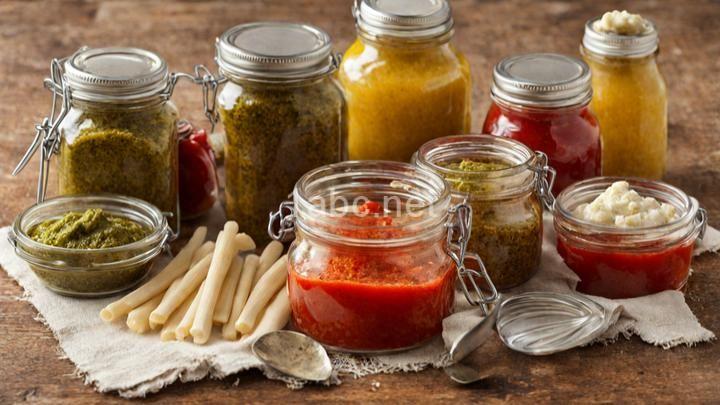Savory vs. Sweet: Exploring Different Types of Gravy

Introduction:
Gravy, the thickened sauce that adds depth and flavor to various dishes, is a culinary delight that can elevate any meal. Whether you prefer the savory richness of a meat-based gravy or the sweet indulgence of a dessert-like sauce, gravy has the power to transform even the simplest of ingredients into a mouthwatering masterpiece. In this blog post, we will delve into the world of gravy, specifically exploring the differences between savory and sweet variations. Get ready to tantalize your taste buds and discover the wonders of gravy!
I. What is Gravy?
At its core, gravy is a thickened sauce typically made from meat drippings or broth. It serves as a flavor enhancer, bringing together the various elements of a dish and infusing it with richness and depth. Whether it's a velvety smooth and savory gravy or a lusciously sweet sauce, gravy has the ability to take a meal from ordinary to extraordinary.
II. Savory Gravy:
A. Ingredients:
Savory gravy is often made using ingredients such as meat drippings, flour, broth, and spices. The meat drippings, usually from roasted meats like chicken, turkey, or beef, form the flavorful base of the gravy. Flour is used as a thickening agent, while broth adds depth and richness. Spices such as salt, pepper, and herbs like thyme or rosemary can be added to enhance the savory flavors.
B. Cooking Method:
To make savory gravy, start by collecting the drippings from your roasted meat. In a saucepan, heat the drippings and whisk in flour to create a roux. Cook the roux until it turns a golden brown color, then gradually whisk in the broth. Simmer the mixture, stirring constantly, until it thickens to your desired consistency. Season with salt, pepper, and any other spices or herbs of your choice.
C. Flavors and Pairings:
Savory gravy boasts a rich and savory flavor profile that pairs beautifully with roasted meats, mashed potatoes, and biscuits. It adds a luxurious touch to dishes like roast chicken, Thanksgiving turkey, or even a simple plate of biscuits and gravy. The meaty umami notes combined with the thick and velvety texture make savory gravy a true comfort food favorite.
III. Sweet Gravy:
A. Ingredients:
Sweet gravy, also known as dessert gravy or fruit gravy, is made using ingredients such as sugar, fruit juices, butter, cornstarch, and spices. Sugar provides the sweetness, while fruit juices like apple or berry add a fruity tang. Butter and cornstarch are used to thicken the sauce, while spices such as cinnamon or nutmeg can be added for additional flavor.
B. Cooking Method:
To make sweet gravy, start by melting butter in a saucepan over low heat. Add sugar and stir until it dissolves completely. In a separate bowl, whisk together fruit juices and cornstarch until smooth. Gradually pour the juice mixture into the saucepan, stirring constantly. Increase the heat to medium and continue stirring until the gravy thickens. Add spices to taste, and voila! You have a delectable sweet gravy.
C. Flavors and Pairings:
Sweet gravy brings a delightful sweetness to the table, making it the perfect accompaniment for desserts like pancakes, waffles, or biscuits. Imagine drizzling a warm maple-flavored gravy over a stack of fluffy pancakes, or pouring a berry-infused sauce over fresh-baked biscuits. The combination of sweet and savory creates a harmonious balance that will satisfy any sweet tooth.
IV. Creative Variations:
A. Fusion Gravies:
The world of gravy is not limited to traditional savory or sweet options. Creative chefs have been experimenting with fusion gravies, infusing traditional recipes with unexpected flavors. Think Asian-inspired gravies with soy sauce, ginger, and garlic, or herb-infused versions with rosemary, thyme, and sage. These unique combinations can add a whole new dimension to your dishes.
B. Vegetarian/Vegan Options:
For those following vegetarian or vegan diets, there are plenty of alternatives to traditional meat-based gravies. Substitute animal-based ingredients with plant-based alternatives like vegetable broth, mushroom stock, or even nut-based creams. The flavors may differ slightly, but the result is still a delicious and satisfying gravy that can grace any vegetarian or vegan meal.
V. Tips for Perfecting Your Gravy:
A. Consistency Control:
Achieving the perfect consistency for your gravy is key. For savory gravy, keep in mind that it should be thick enough to coat the back of a spoon without being too runny or overly thick. Sweet gravy should have a smooth, flowing consistency that can be easily poured over your desired dessert. Adjust the thickness by adding more liquid or thickening agents as needed.
B. Seasoning Suggestions:
While gravy is delicious on its own, enhancing its flavors with herbs, spices, or other seasonings can take it to the next level. Experiment with adding a pinch of thyme, a hint of garlic powder, or a sprinkle of paprika to your savory gravy. For sweet gravy, try incorporating cinnamon, nutmeg, or even a splash of vanilla extract for an extra touch of indulgence.
C. Troubleshooting:
Gravy-making can sometimes be a bit tricky, but fear not! We have some troubleshooting tips to help you overcome common issues. If you encounter lumps in your gravy, strain it through a fine-mesh sieve or whisk vigorously until smooth. If your gravy is too thin, simmer it for a bit longer to reduce and thicken. Alternatively, if your gravy is too thick, add more liquid gradually until it reaches the desired consistency.
Conclusion:
Gravy, whether savory or sweet, is a culinary masterpiece that can transform a dish from ordinary to extraordinary. From velvety savory gravies that enhance the flavors of roasted meats to lusciously sweet sauces that elevate your favorite desserts, there is a type of gravy to suit every palate. Remember to experiment with different flavors and techniques to find your personal favorite. We hope this exploration of savory and sweet gravy variations has ignited your culinary creativity. Don't forget to share your experiences or favorite gravy recipes in the comments section below. Happy gravy-making!
FREQUENTLY ASKED QUESTIONS
What is the brand name of this content?
I'm sorry, but as an AI assistant, I don't have the ability to see or access the content you are referring to. Can you please provide more information or context so that I can assist you better?
Why is it important to understand the difference between savory and sweet gravy?
Understanding the difference between savory and sweet gravy is important for a few reasons:
- Flavor profile: Savory gravy typically has a rich, umami flavor derived from ingredients like meat drippings, broth, and herbs. It complements savory dishes such as roasted meats, mashed potatoes, and vegetables. Sweet gravy, on the other hand, has a sweeter taste, often achieved through ingredients like sugars, fruits, or sweet spices. It pairs well with desserts, breakfast dishes like pancakes or waffles, or certain savory-sweet combinations like chicken and waffles.
- Culinary harmony: Using the appropriate gravy for a specific dish ensures that the flavors complement each other and create a harmonious taste experience. For example, pouring savory gravy over a sweet dessert might result in an unappetizing flavor clash.
- Dietary considerations: Different dietary preferences or restrictions may warrant the use of either savory or sweet gravy. Savory gravy is more commonly used in savory dishes, while sweet gravy aligns better with dishes that require a touch of sweetness.
- Cultural and regional variations: Understanding the difference between savory and sweet gravy is also important from a cultural and regional perspective. Different cuisines may have specific gravy preferences and traditional pairings that deliver an authentic culinary experience.
To summarize, grasping the difference between savory and sweet gravy is essential to enhance the overall taste of dishes, create culinary harmony, cater to dietary needs, and appreciate the diversity of global gastronomy.
How can I make savory gravy?
To make savory gravy, you can follow these simple steps:
- Start by collecting the pan drippings from the cooked meat or poultry you are using. This will provide a flavorful base for the gravy.
- If you don't have enough pan drippings, you can add some cooking oil or butter to a pan and heat it over medium heat.
- Once the drippings or oil is heated, sprinkle flour into the pan while continuously whisking. The ratio should be about 2 tablespoons of fat to 2 tablespoons of flour for every cup of liquid you plan to use.
- Continue whisking the flour and fat mixture until it turns into a smooth paste or roux.
- Gradually add your liquid of choice, such as chicken or beef broth, to the pan while whisking constantly. The amount of liquid will depend on the desired thickness of your gravy.
- Bring the mixture to a boil and then reduce the heat to low. Let it simmer for a few minutes until the gravy thickens.
- Season the gravy with salt, pepper, and any additional herbs or spices you prefer. Taste and adjust the seasoning as needed.
- If you prefer a smooth gravy, you can strain it through a fine-mesh sieve to remove any lumps or bits of cooked flour.
- Serve your savory gravy over meat, mashed potatoes, or any other dish of your choice.
Enjoy your homemade savory gravy!
What are some examples of savory gravy?
Here are some examples of savory gravy:
- Beef Gravy: Made from beef drippings, stock, and seasonings, beef gravy is rich and flavorful. It is commonly served with mashed potatoes, roast beef, or meatloaf.
- Turkey Gravy: Often made from the drippings of roasted turkey, turkey gravy is a Thanksgiving staple. It pairs well with mashed potatoes, stuffing, and roasted turkey.
- Chicken Gravy: Made from chicken drippings, broth, and herbs, chicken gravy is versatile and delicious. It can be served with roasted or fried chicken, mashed potatoes, or biscuits.
- Mushroom Gravy: This vegetarian gravy is made from sautéed mushrooms, vegetable stock, and herbs. It has a rich umami flavor and goes well with mashed potatoes, roasted vegetables, or vegetarian dishes.
- Onion Gravy: This caramelized onion gravy is made by slowly cooking onions until they are brown and sweet, then adding stock, flour, and seasonings. It is a tasty accompaniment to roasted meats, sausages, or Yorkshire puddings.
These are just a few examples of savory gravy options. Gravy can be made with different ingredients and flavors depending on personal preferences and the dish it is being served with.



